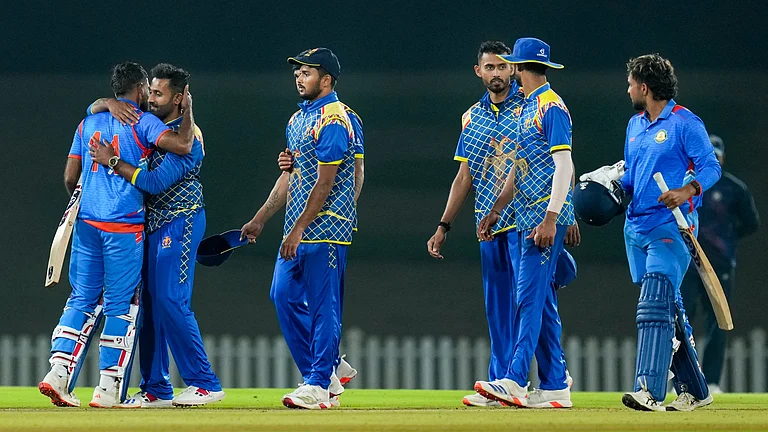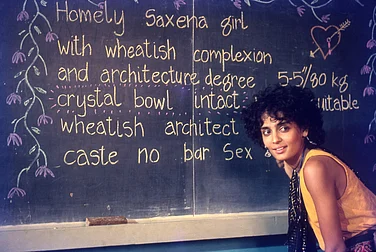Indian cinema scholars have written extensively on the crucial decade after Independence, particularly the 1950s, when the Nehruvian vision of balancing industrial progress with equity found its cinematic expression in the coexistence of tradition and modernity on screen. Films like Mehboob Khan’s Mother India (1956) and B.R. Chopra’s Naya Daur (1957) are cited as instances of such a claim.
Mother India’s narrative is bookended with shots of the titular Radha (Nargis), who toils hard almost singlehandedly to raise her sons, against the backdrop of exploitation by Sukhilala or Lala (Kanhaiyalal Chaturvedi), the feudal landlord/moneylender. The scene is that of a dam being inaugurated by the elderly and frail Radha. The transition of the transparent water into a blood-red hue and back, provides the frame for moving into the narrative, that begins with Radha as a newly-married young wife, continues with flashbacks of her life, and ends by returning to the film’s present. Within the flashbacks, there is the climax in which she shoots down and sacrifices her beloved-but-spoilt son Birju for the sake of her village and for the honour of its women, like Lala’s daughter Rupa (Chanchal), who Birju and his gang had kidnapped on the day of her marriage.
In a similar vein, Kalyani (Sriranjani), the helpless younger sister around whom the narrative of the hit Tamil film Parasakthi (directors: Krishnan-Panju, 1952) revolves, goes through a series of misfortunes, including the loss of her father and young husband soon after the birth of her son and the exploitation of her status as a single mother by lecherous men who harass and abuse her to the point where she tries to commit suicide, almost jumping into a river from a bridge after throwing her infant son into the water. The police intervenes and stops her from jumping into the water, and proceeds to charge her for killing her son and attempting to commit suicide.

Contrary to Radha, whose sacrifice attains meaning in the modernity that promises to bring economic prosperity to a transforming feudal space with the death of Sukhilal, Kalyani’s sacrifice to nurture her infant son does not get similar importance, since the focus towards the climax is on her predicament as a woman, rather than as a mother. Unlike the modernity symbolised by the construction of the dam—indicated by busy excavators and heavy machinery in Mother India’s title sequence—modernity intervenes in the form of democratic court procedures during the climactic sequence of Parasakthi. As opposed to Radha, who survives her tragic circumstances with resilience and honour, Kalyani is left further desolate, as her brother Gunasekaran (Sivaji Ganesan) has to seek justice on her behalf.
ALSO READ: OTTs Are The New Mainstream, Here's How
Gunasekaran addresses the judge and viewers while facing the camera, and says: “Odinaal, odinaal, vazhkayin orathirkke odinaal (She ran and ran till the very edges of life)”. This dialogue, written by Kalaignar Karunanidhi, became one of the most cited in the history of Tamil cinema. Gunasekaran recites it while detailing how his sister Kalyani was molested by the temple priest (K.P. Kamakshi) who tried to rape her inside the sanctum sanctorum of the Parasakthi temple. It recalls a similarly provocative and subversive sequence in Velaikkari (Maid Servant), released three years before in 1949, which was written by Karunanidhi’s mentor Arignar Anna.
Such sequences mark their difference from an earlier Tamil cinema by reversing the hagiography surrounding the mythological, and questioning irrationality and exploitation in the name of faith. They are far removed from the critical scene in Mother India, where, for the sake of her sons who are dying from hunger, Radha caves in to the lustful Lala’s invitation, and despairingly enters his home, coldly offering her body soiled by the mud from the floods that have devastated her life, in return for food to feed her starving and sick children, particularly Birju, who is down with high fever. When the prurient Lala tries to embrace her forcefully, Radha plucks the mangalsutra from her neck and throws it away in anger, sacrificing the emblem of her faith in the survival and return of her loving husband, long after he had abandoned her when he lost his arms in an accident, after a rock fell on him while he was tilling the land.
Serendipitously, in one of the iconic moments of melodrama in Indian cinema, the mangalsutra falls resting on a small wooden shelf on which sits a statuette of the goddess Lakshmi. Later, we see Radha benumbed by Lala’s gesture of adorning her with a gold chain. She challenges the goddess, “Sansar ka bhaar utha loge Devi, mamta ka bhoj uthaya na jayega (You can bear the weight of the world, but not the burden of motherhood)”, even as Lala is trying to remove the distracting shelf on which the idol is kept. While struggling with Lala to hold on to the idol—witness to the loss of her laaj (honour)—she accidentally discovers the mangalsutra she had discarded in anger.
Its continuing presence on the wooden stand, along with the idol of the goddess, assures the well-being of her husband and children, instantaneously energising a disconsolate Radha, who, thereafter, finds the power not only to deny Lala but also to attack him. She returns with her honour as a pativrata (chaste wife) remaining unscathed, despite the endless misery she suffers in an unequal agrarian society where modernity—in the form of technology/tractors has not still entered. In Parasakthi, however, Kalyani is disallowed from committing suicide and forced to bear the guilt of killing her son and the humiliation of getting arrested, unlike Radha, who is not questioned for murdering her rebellious son, and is instead revered as Mother India—who will restrain the fury of nature and floods in future through the inauguration of the dam.

These two critical sequences of young and single mothers Radha and Kalyani, mark the ideological differences in popular Hindi and Tamil cinema in the crucial decade after Indian independence. Driven by socialism—as exemplified by the sickle in the logo of his production company Mehboob Productions—Mehboob Khan remade his film Aurat (1940) and revised it to pay homage to the Soviet filmmaker Alexander Dovzhenko. He continued to put his faith in the Nehruvian vision of socialism, where egalitarianism and democratic ideals like freedom of speech, faith and religion were guaranteed.
As the title indicates, Mother India is a critique of the feudal past, while expectantly anticipating a modern India in the future, as promised by the Congress government led by Nehru. In the film, this is emblematised by Congress leaders wearing their distinct white caps surrounding Radha in the scene bracketing the long flashback. In contrast, Gunasekaran arrives from the war-torn Rangoon to meet his sister Kalyani, only to be surrounded by beggars in Chennai, and be relieved of his belongings by a deceitful woman, who leads him to a (North Indian) hookah joint to be regaled by a dancer (Kumari Kamala).
Parasakthi thus inverts the Gandhian and pro-Independence/Congress party agenda of Tamil films of the pre-Independence years, as exemplified by director K. Subrahmanyam’s Seva Sadhanam (1938) and Thyaga Bhoomi (1939). Parasakthi is justly suspicious of the euphoria, and in its subnational imperatives, interrogates the North Indian/Congress party hegemony, synonymous with the vision of Prime Minister Nehru and his mentor Gandhi, and the latter’s faith in religion. In the footsteps of their iconic mentor Periyar, preeminent Dravidian ideologues like Annadurai and Karunanidhi, questioned the irrationality surrounding religion and caste, while also challenging the monolithic idea of the nation that imposes its will from above. However, in their investment in electoral politics, they departed from their mentor Periyar by trying to be more inclusive via unifying slogans like “Ondre kulam-oruvane devan (One community-one god)”, and more importantly, away from Periyar’s total investment in the empowering of women. As self-confessed cinephiles, theatre aficionados and playwrights, they accepted the stereotypical and entrenched trope of the abalaippen—the helpless and despondent woman who has to be rescued by a man.
To conclude, the legacy of Dravidian cinema of the 1950s continues in the works of pioneering Dalit filmmaker Pa. Ranjith. Like the Dravidian ideologues of yore, Ranjith uses the space of mainstream cinema to engage with and foreground Dalit identity and voices, and recover the narratives of those on the fringes.
Unlike similar efforts in Hindi cinema, where a film like Article 15 (director: Anubhav Sinha, 2019) still needs a non-Dalit protagonist to speak on behalf of the Dalits, Ranjith’s protagonists and their milieu are clearly marked as Dalit.
ALSO READ: Demigods Of South Indian Cinema
Nevertheless, by drenching the contested wall—the centre of his narrative in Madras (2014)—with the blue colour of the Republican Party of Babasaheb Ambedkar, Ranjith unequivocally questions the erasure of Dalit presence through the overwhelming ubiquity of black, red and white in Tamil society/cinema, from the 1960s onwards. Indeed, traces of the 1950’s Dravidian cinema is visible in Ranjith’s characterisation of the religious and ‘white’ antagonist Nana Patekar, as opposed to the ‘black’ protagonist played by Rajinikanth in Kaala (2018), wherein the agenda of the Hindu religious right (BJP) and the ‘anti-Madrasi’ rhetoric of the local party (Shiv Sena) are effectively juxtaposed.
(Views expressed are personal)
Swarnavel Eswaran is associate professor of english and journalism at michigan state university























